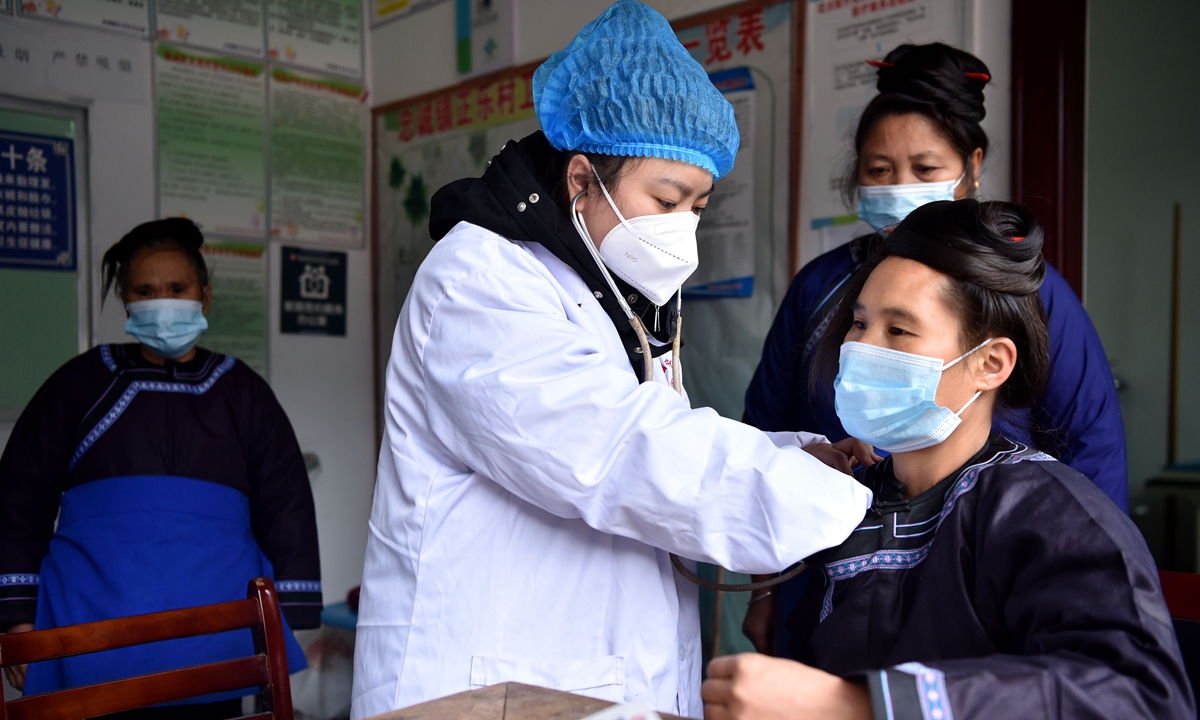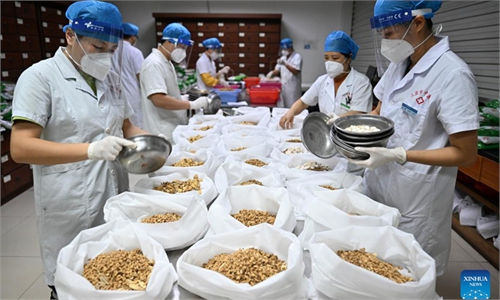
A doctor is examining the health condition of a villager in rural areas of Southwest China's Guizhou Province on December 25, 2022. Photo: VCG
China's vast rural areas are facing increasing challenges as people are returning home from cities for the upcoming new year and Spring Festival holidays, while the country is fighting a COVID-19 infection surge. To deal with possible impacts on rural areas, Chinese authorities have ramped up efforts to add medicine stockpiles and aid clinics and hospitals in rural areas.
Xi Jinping, general secretary of the Communist Party of China Central Committee, demanded more targeted efforts to carry out patriotic health campaigns and concrete actions to protect people's safety and health.
Xi, also Chinese president and chairman of the Central Military Commission, made the instruction concerning the 70th anniversary of the patriotic health campaigns.
Chinese authorities have stressed the importance of prevention work in rural areas and in recent weeks with governments at all levels having been busy with promoting prevention measures in rural cities.
On Saturday, several departments, including the Ministry of Agriculture and Rural Affairs and the National Rural Revitalization Administration, held a video conference to stress the urgency and significance of the prevention work in rural areas.
The conference pointed out that some rural areas are facing a shortage of medicine and have limited resources in treating patients with severe conditions. Local governments should make more detailed plans to ensure the safety of rural residents.
The number of people coming to a village hospital in Southwest China's Chongqing Municipality has increased to a few dozen every day and more than half of them - who are elderly - are infected with Omicron, a doctor from the hospital told the Global Times.
The most challenging problem is the shortage of medicine and medical staff, as more than a dozen of the medical staff in the hospital has been infected. But those with mild illness are still working. To deal with the shortage of medical staff, doctors have prolonged their working time. Patients with severe illness will be immediately transferred to a hospital in township for treatment, according to the doctor.
The current situation is not that severe but there may be more infections around the Spring Festival holidays, said the doctor, noting that they have contacted pharmaceutical factories to get more medicine.
A hospital in Wangkui county in Suihua city of Northeast China's Heilongjiang Province has also seen more patients with fever in recent weeks. Similar to the village hospital in Chongqing, more than 40 medical staff members in the Wangkui county hospital have been infected.
"We experienced a little infection peak one month ago and many residents here have recovered," a doctor who asked for anonymity told the Global Times.
Facing the flow of people returning from cities, the doctor said they have made plans. But many of these people may have already been infected in big cities before coming home.
What happened to the two hospitals epitomizes the situation of hundreds of other hospitals and clinics in China's vast rural areas. Analysts said that the challenges these hospitals are facing have increased amid this round of infections across China, as the rural population is more aged and vulnerable but the vaccine rate is lower than in big cities. The rate of serious illness may be higher, so there may be an impact on medical resources.
Peng Jie, director of the center for difficult disease infections at Southern Hospital of Southern Medical University, said in an interview with China News Weekly that rural areas may face many challenges due to the large number of elderly people and children, the lack of medical resources and poor awareness of scientific treatment.
With county hospitals as the core, township health centers as the hub and village health offices (clinics) as the foundation, a three-tier health care network has been constituted in China's rural areas. Whether the primary health institutions can fully play their role will determine whether the rural areas can minimize the rate of serious illness and death and achieve a smooth transition under the impact of the first exit wave, observers noted.
According to data released by China's National Health Commission, nearly 980,000 primary health care institutions nationwide were registered as of the end of 2021, including 35,000 township health centers and 599,000 village health rooms.
On December 15, the State Council issued a work plan to strengthen the reserves of essential drugs and COVID-19 home test kits in rural areas.
Aside from working to strengthen the reserves of essential drugs, many hospitals and clinics in villages and townships have cooperated with superior hospitals in offering timely treatments, the Global Times has learned. For example, hospitals in East China's Anhui are sending a team of experts to guide hospitals in towns to promote their capability in diagnosis and treatment. Medical staff members in villages are offering consultations to rural residents via phone or video.
To increase residents' knowledge of the virus, a village in Nanyang of Central China's Henan Province uses loudspeakers to popularize prevention and disinfection measures. Village officials are working with local medical staffers in publicizing the innovation of vaccines.
There are more challenges for prevention work in rural areas especially when more people are returning home for the upcoming hospitals. Analysts called on local governments to make more preparations and strengthen health monitoring of vulnerable groups, especially the elderly, and further smooth the green channels for patients with severe symptoms.

